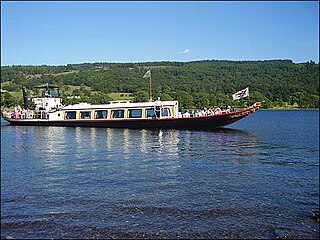
A boiling water reactor (BWR) is a type of light water nuclear reactor used for the generation of electrical power. It is the second most common type of electricity-generating nuclear reactor after the pressurized water reactor (PWR), which is also a type of light water nuclear reactor.

A boiler is a closed vessel in which fluid is heated. The fluid does not necessarily boil. The heated or vaporized fluid exits the boiler for use in various processes or heating applications, including water heating, central heating, boiler-based power generation, cooking, and sanitation.

A kettle, sometimes called a tea kettle or teakettle, is a device specialized for boiling water, commonly with a lid, spout, and handle. There are two main types: the stovetop kettle, which uses heat from a hob, and the electric kettle, which is a small kitchen appliance with an internal heating element.

A feedwater heater is a power plant component used to pre-heat water delivered to a steam generating boiler. Preheating the feedwater reduces the irreversibilities involved in steam generation and therefore improves the thermodynamic efficiency of the system. This reduces plant operating costs and also helps to avoid thermal shock to the boiler metal when the feedwater is introduced back into the steam cycle.

A deaerator is a device that is used for the removal of dissolved gases like oxygen from a liquid.

The steam-electric power station is a power station in which the electric generator is steam driven. Water is heated, turns into steam and spins a steam turbine which drives an electrical generator. After it passes through the turbine, the steam is condensed in a condenser. The greatest variation in the design of steam-electric power plants is due to the different fuel sources.
Economizers, or economisers (UK), are mechanical devices intended to reduce energy consumption, or to perform useful function such as preheating a fluid. The term economizer is used for other purposes as well. Boiler, power plant, heating, refrigeration, ventilating, and air conditioning (HVAC) uses are discussed in this article. In simple terms, an economizer is a heat exchanger.

Kelly Kettle, Storm Kettle, Ghillie Kettle, Thermette, Survival Kettle and Volcano Kettle are trade names for portable devices for boiling water outdoors using twigs and other small combustible materials; these devices consist of a water jacket surrounding a fire chamber which creates an upward chimney draft ensuring efficient and rapid boiling even in windy or wet weather.

An electric water boiler, also called a thermo pot, is a consumer electronics small appliance used for boiling water and maintaining it at a constant temperature in an enclosed reservoir. It is typically used to provide an immediate source of hot water for making tea, hot chocolate, coffee, instant noodles, or baby formula, or for any other household use where clean hot water is required. They are a common component of Japanese kitchens and the kitchens of many East Asian countries but are found in varying use globally. Smaller units are portable. Some thermo pots are designed with a feature that can purify water.

A boiler or steam generator is a device used to create steam by applying heat energy to water. Although the definitions are somewhat flexible, it can be said that older steam generators were commonly termed boilers and worked at low to medium pressure but, at pressures above this, it is more usual to speak of a steam generator.

Windermere Jetty: Museum of Boats, Steam and Stories is a museum on the eastern shore of Windermere between Bowness-on-Windermere and the town of Windermere in Cumbria, England. It reopened in March 2019 after 12 years' closure and redevelopment work.

The steam yacht Gondola is a rebuilt Victorian, screw-propelled, steam-powered passenger vessel on Coniston Water, England. Originally launched in 1859, she was built for the steamer service carrying passengers from the Furness Railway and from the Coniston Railway. She was in commercial service until 1936 when she was retired, being converted to a houseboat in 1946. In 1979, by now derelict, she was given a new hull, engine, boiler and most of the superstructure. She is back in service as a passenger boat, still powered by steam and now operated by the National Trust.

A naphtha launch, sometimes called a "vapor launch", was a small motor launch, powered by a naphtha engine. They were a particularly American design, brought into being by a local law that made it impractical to use a steam launch for private use.
Boilers for generating steam or hot water have been designed in countless shapes, sizes and configurations. An extensive terminology has evolved to describe their common features. This glossary provides definitions for these terms.

Three-drum boilers are a class of water-tube boiler used to generate steam, typically to power ships. They are compact and of high evaporative power, factors that encourage this use. Other boiler designs may be more efficient, although bulkier, and so the three-drum pattern was rare as a land-based stationary boiler.

Spiral water-tube boilers are a family of vertical water-tube boilers. Their steam generating tubes are narrow spiral tubes, arranged in circular fashion around a central vertical water drum.

An evaporator, distiller or distilling apparatus is a piece of ship's equipment used to produce fresh drinking water from sea water by distillation. As fresh water is bulky, may spoil in storage, and is an essential supply for any long voyage, the ability to produce more fresh water in mid-ocean is important for any ship.
A steam generator on a ship is an auxiliary boiler which draws high-pressure superheated steam from the vessel's propulsion system to generate low pressure saturated steam. This secondary steam is then used to power auxiliary shipboard engines driving winches or pumps, or to meet any steam requirement that does not require superheating, such as boiler feedwater and freshwater evaporators.

A steam generator is a form of low water-content boiler, similar to a flash steam boiler. The usual construction is as a spiral coil of water-tube, arranged as a single, or monotube, coil. Circulation is once-through and pumped under pressure, as a forced-circulation boiler. The narrow-tube construction, without any large-diameter drums or tanks, means that they are safe from the effects of explosion, even if worked at high pressures. The pump flowrate is adjustable, according to the quantity of steam required at that time. The burner output is throttled to maintain a constant working temperature. The burner output required varies according to the quantity of water being evaporated: this can be either adjusted by open-loop control according to the pump throughput, or by a closed-loop control to maintain the measured temperature.

A thimble tube boiler is a form of steam boiler, usually provided as an auxiliary boiler or heat-recovery boiler. They are vertical in orientation and would be considered a form of water-tube boiler.

















